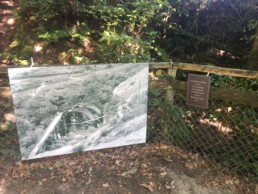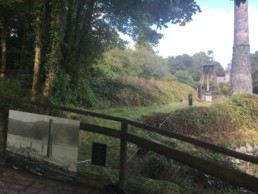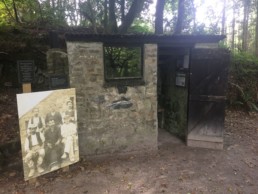ECHOS OF THE PAST
CURATED BY ALEXANDER THOMAS AT WHEAL MARTYN CLAYWORKS
This outdoor exhibition features historic photographs from Wheal Martyn’s archive, combined with poetry written by our Trainee Curator, Alexander Thomas, to help evoke a sense of understanding of the Cornish china clay industry – how it was, how it operated, and what has become of it in the centuries since its founding.
Each image has been carefully selected and placed to give a sense of Wheal Martyn’s past and present. Together with Alexander’s poetry, we want to encourage visitors to write and send in their own poetry around Clay Country.
I wrote poetry over the Summer and it wil be displayed on induvidual display boards alongside each different image or set of images. Inspired by spending time out and about on site, at times simply sitting by each landmark, such as the water wheels or pit view and immersing myself in the sight of them their motion and the atmosphere around them.
CURATORIAL TASK: REFLECTIVE WRITING
Echos of The Past – A Retrospective
Taking your first exhibition through from conception to delivery is a strange experience, but an absolutely amazing one. To go from a tiny kernel of an idea inside your head to the completion of a full installation requires many things: vision, determination, and the ability to adapt to changing circumstances. At least, that is how I have found things during the development of my exhibition “Echoes of the Past” here at Wheal Martyn.
Echoes of the Past was born from a conundrum: I needed to complete a live project as part of my trainee curatorship and yet we had no space at Wheal Martyn to hold it. Thanks to Covid-induced changes to our exhibition schedule, we had Kurt Jackson’s ‘Clay Country’ on display in our new gallery space, whilst our education space was the home of “China Clay in Your Everyday”, our summer tent-pole exhibition. But Wheal Martyn has more than just its buildings to work with.
Remembering the first project I assisted on (once I got down to Cornwall from Wales anyway), I decided to create the next instalment of Wheal Martyn’s series of outdoor photographic exhibitions, set among its 26-acre site. This was well-received by Wheal Martyn staff as the display boards from the previous exhibition were beginning to show their age – having spent five months exposed to the elements the foamex boards werestarting significantly warp and in some cases had been damaged. So with the format decided, I now needed to decide on the content.
The two previous outside photographic exhibitions had been created from pictures sent in by members of the public in response to social media campaigns run by Wheal Martyn to give people something to do whilst the site was closed during lockdown. I had a different idea however, stemming from both the fact there was no lockdown to give that level of impetus to engagement, as well as another project I had been involved in during my time at Wheal Martyn. For the length of my traineeship Ihad been given the responsibility for Wheal Martyn’s Clay Stories, our series of weekly social media posts featuring images from Wheal Martyn’s extensive photographic archive. These posts have been regularly popular amongst out followers and so they inspired me to go one further and make an entire exhibition dedicated to our photographic archive, so as to widen awareness of its existence and increase public engagement with it.
Photography is only the first part of Echoes of the Past, the second half is poetry. Creative writing has always been a hobby of mine and whilst I was unfamiliar with poetry as a medium before, I knew its power to invoke emotion and create imagery. I knew that if I was going to attempt to do both those things with the photographs from the archive, it would need to be accompanied by suitably thematic pieces so as to increase the visitors’ engagement with said photographs.
Of course, no idea is perfect and no exhibition’s development is without issue. The most significant to afflict Echoes of the Past was the matter of public engagement. In feedback given on the proposed plans, the idea that there was relatively little engagement with the visitors beyond their consumption of both the images and poetry were raised and they were absolutely right. So, in answer to this issue I workshopped ideas with colleagues and came up with an effective public engagement plan. This consisted of a social media strategy to raise awareness; adding further boards encouraging members of the public to contribute their own poems; a trail for children; and later on the addition of luggage labels being handed out at the welcome desk so that people could write down their ideas for their own poems as they wandered around site, enjoying the exhibition.
The second problem that arose during the exhibition was the issue of the colour scheme. Initially, owing to the black and white nature of the photographs, I had envisioned a colour scheme of white text on a black background. However, whilst some people find such a colour scheme soothing and easier to read – as evidenced by the ‘dark modes’ available on many screens and programmes – I discovered others, such as those suffering from Astigmatism, find the contrast to be straining to their eyes. Luckily, this was before any materials were sent to the printers and so it was a relatively quick fix: I simply altered the white text to a softer light grey, maintaining the desired colour scheme without causing any undue strain to visitors.
Other minor problems included one board needing to be reprinted and myself sustaining a variety of superficial cuts to my hands during the installation due to the aluminium boards’ squared off edges. Both of these have been lessons that I have gained knowledge from, which I will carry forward into later exhibitions during my career. The first is to always have someone else read the proofs of any text, because having written it yourself your mind is more likely to skip over typos or insert words that aren’t because you know what you meant to say, and to always wear gloves whilst handling squared off pieces of metal, even if they don’t look sharp. On the other hand, however, Echoes of the Past provided many successes during its conception, preparation, and installation.
One of the key successes was the change from foamex boards to a far better material. As mentioned previously, the foamex boards used in previous outside exhibitions have had an unfortunate tendency to warp and become damaged when exposed to the elements. Furthermore, they are not ecologically viable, being near impossible to either recycle or reuse. I therefore knew that going forward, things would have to be different. I talked with our printers and they suggested Aluminium Composite. The Aluminium Composite was a great success. It’s light, solid, and won’t warp in the elements. Secondly, the finish is fantastic and helps present Wheal Martyn in a positive and professional light. Furthermore, they can simply be returned to the printers and be re-clad with future exhibition materials, cutting down on wastage and proving itself an ecological boon to the site.
Another success was the scope of the project. Previous exhibitions had confined themselves only to the historical trail on-site. But Echoes of the Past expanded that to across the entire site, including pit view (see Image 1) and the nature trail. This hopefully will help increase visitor interaction with the site as a whole, rather than confining themselves to one small part of it.
On a personal level of success, I also managed to develop my experience in both exhibition design and in creative writing (poetry specifically). Both of these have helped me develop and will doubtlessly serve me well in my career from here on out. And finally – perhaps most importantly – the exhibition has had a success in the form of the positive feedback that it has received from the general public. The positive comments received so far, when the exhibition has barely launched, grant a great sense of vindication and hopefully a sign of more to come between now and when it closes in March 2022. To conclude, Echoes of the Past has had its problems but – as my colleagues have assured me – that is something all exhibitions face. And for all those problems, the successes and the experiences have made them all worth it.


